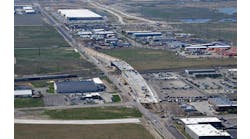By Oana Crisan, Contributing Author
For nearly 100 years, the rainbow arch of the Robert Street Bridge has been an iconic landmark in St. Paul, Minn., and the Minnesota Department of Transportation (MnDOT) plans to keep it that way.
MnDOT has scheduled a significant renovation that will shore up the historic bridge for another 50 years. The project aims to secure the future of this piece of St. Paul’s history while modeling technological advancements that will become benchmarks for the bridge industry.
Led by Barritt Lovelace, vice president of UAS, AI, and reality modeling, Collins Engineers maximized the data it collected by using drones to capture more than 57,000 images of the bridge.
Using reality modeling software, the inspection team processed the drone-captured images to create a detailed digital twin of the bridge. This capability allowed senior engineers on the project to pre-inspect the bridge and study its condition and document defects before going to the site in person. Once in the field, engineers could reference the 3D digital replica on internet-enabled tablet computers and annotate the model with additional findings.
By using these digital delivery methods, Collins Engineers’ team was able to cut down its time spent on site. This meant fewer roadway closures and traffic disruptions for commuters. It also freed engineers to focus on the project’s critical next step: assessing the bridge’s load-carrying capacity and developing a bridge management plan to present to project designers.
“Engineers were spending their time making decisions versus collecting data,” Lovelace said.
By making the digital twin available to potential contractors for more detailed insight into the structural condition of the bridge, Collins Engineers expects to save approximately 20% in rehabilitative construction costs.
Lovelace believes that doing so well help the potential contractors be able to submit more accurate construction bids. He estimates that this information sharing will result in up to $15 million in savings for MnDOT and a 10% reduction in materials used during the construction process.
Combatting a Workforce Squeeze
Digital innovations also helped the engineering team mitigate a workforce shortage that currently stretches across the bridge industry.
Lovelace said that not enough new engineers are entering the workforce to keep up with the rapidly growing demand for their skills, as a slew of American bridges and other infrastructure age past the 50-year mark.
“[American] infrastructure is in the second generation of needing repairs,” he said.
On the Robert Street Bridge inspection, artificial intelligence capabilities helped compensate for having fewer workers available for fieldwork by cutting down on the overall time and labor required on site. This situation yielded more than $90,000 in savings.
As a result of these benefits, Lovelace said he expects a digital-first workflow will be the norm for him and his colleagues moving forward.
“Even in cases where the client isn't specifically asking us to do this, we’re proposing it, because we know we can give them a better product at a reduced cost compared to traditional methods,” he said.
Lovelace Leads the Way
Lovelace has considered bridges from many perspectives in his career. Across nearly 30 years as a structural engineer and bridge inspector, he has dived to underwater sites and climbed to inspect structures only accessible by rope. Now, as vice president of UAS, AI, and reality modeling at Collins Engineers, Inc., he uses drones and digital twins to see bridges from new angles.
“I was always interested in bridges for the same reason everybody’s interested in bridges,” Lovelace said. “They tend to be landmarks that connect people and communities.”
Lovelace has indeed had the opportunity to work on prominent structures, including his contributions to the restoration of Minneapolis’ iconic Stone Arch Bridge and, most recently, St. Paul’s historic Robert Street Bridge.
He began developing the niche expertise that has brought him leadership opportunities on many notable projects in 2015, when Collins Engineers received grant funding from MnDOT to consider how drones might be used for bridge inspection.
At the time, Lovelace managed the company’s regional office in Minnesota. However, as demand grew for his digital skillset, he had the chance to take on a leadership role dedicated to technological advancement in the bridge industry.
“We kind of became the benchmark when [the industry] was first starting to use drones in bridge inspections,” he said.
Now, Lovelace not only guides the technology side of major bridge inspection projects, but also consults with various state agencies that want to build up their own digital inspection capabilities. He says that it has been rewarding to be a part of this industrywide forward momentum.
“Getting to work with DOTs all over the country the last few years has been really interesting,” he said. “It’s always fun helping agencies implement this technology and start taking advantage of it.”
Lovelace is also excited to see these technologies open the door for new engineering talent to join the industry at a time when aging infrastructure around the country is heightening demand for their skills.
He believes that the industry will also become more welcoming to gifted engineers who have historically faced barriers to bridge inspection work due to its physical demands.
“I think incorporating artificial intelligence, drones, and digital twins has really helped us attract some of the best and brightest engineers into this field because suddenly, it became very high-tech,” Lovelace said. RB
Oana Crisan is a senior product marketer focused on bridge design and analysis applications at Bentley Systems. She can be reached at [email protected].



